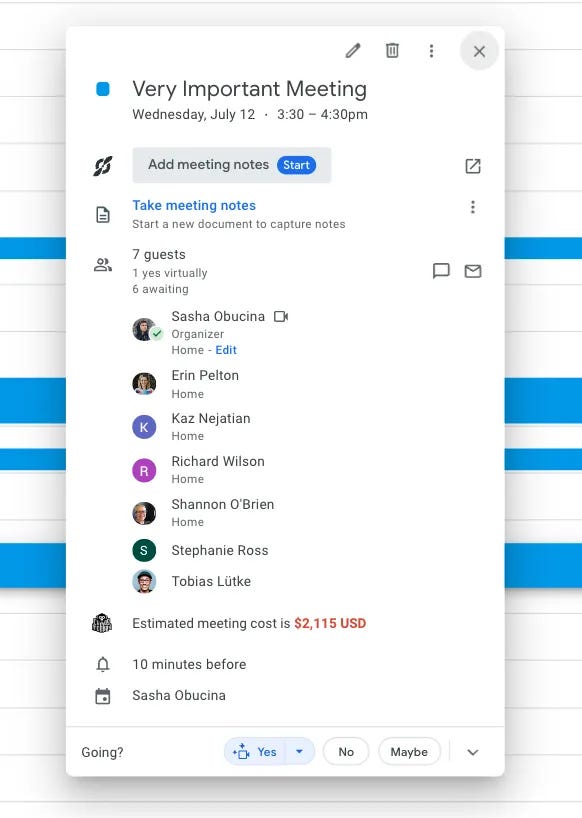On Cost of Meetings
Two days before, I saw a random tweet - a screenshot of an app and a mockup as a reply. And a friend shared an article over it.


In fact, the mockup in the right makes more sense - along with the cost, it directly gives me an option to cancel the meeting and send a mail communique instead.
So, what's the background of this sudden interest to a 2016 HBR concept? I really have no idea. But, I am seeing a recent interest in increasing productivity by reducing meetings. The first screenshot is from a Shopify internal app which puts a cost to the meeting. Notes Kaz Nejatian, Shopify’s COO,
No one at Shopify would expense a $500 dinner…But lots and lots of people spend way more than that in meetings without ever making a decision. The goal of this thing is to show you that time is money. If you have to spend it, you think about it.
Take the case of a single Steerco meeting. You will have a weekly meeting and you are bound to have a spate of top-down meetings to gather and fine-tune the information and hours of preparation for such meetings. If you assume 25 teams under one of the departments, you are going to have
One Steerco, one meeting with 25 team leads by the Department Head and one meeting each for each of the team and any number of meetings where interaction of multiple teams is needed. And this, for every department. Just for one department, we are looking at 25 1 hour meetings, 1 two hour meeting excluding the Steerco and other adhoc meetings, we are looking at 27 hours or 3 Person Days of effort. And per year, it becomes 150 days of effort just to prepare for Steerco!!
A recent Wrike Research Report which came a week ago also stresses the same.
So, where exactly is the problem? While resource allocation and asset procurement is diligently tracked, time isn't so. A considerable part of those, in reality, add no value to the discussion but are invited. On one side, it locks their time and on the other hand, it leads to bad practices like multitasking and divided attention. And with no time available, one would see people booking meetings even if a person is busy and not considering his personal limitations. This actually creates a different kind of problem - neither can he reject a meeting and offend the organizer nor can he accept and create a backlog of his work. And this has become more pervasive an issue with the advent of digital communications - the cost and ease of setting up conferences over remote locations has come down drastically . And because there is not much cost involved(a decade ago, you had to book an audio bridge, conference room and all. Today?), meetings have now changed from collaboration to get things done to interaction.
There is no easy way out. But HBR suggests some things.
Have a clear agenda and give an option to opt out. If the meeting is not fruitful (no decision, no preparation etc), cancel it and give an offline chance to conduct the affairs
Have standard, cyclic meetings instead of ad-hoc meetings. They will help plan time well.
A mandatory and approved business case for every new initiative will help achieve a level of convergence on the discussion
Reduce the number of organisational layers and vet any unwanted roles. This, frankly, is not easily doable.
Notify the cost factor for each meeting
Have a clear decision making matrix as a ready reference to reduce going to the wrong person.
In fact, this shouldn't end there. While the cost factor of meetings is being calculated, one should also account the cost of lost opportunities by having meetings as well as not having meetings. The start, however, can be something similar to the points above and the mockup with an option to send a mail instead of setting up a meeting.



